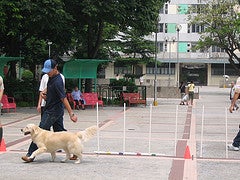Teaching A Dog To Heel - The Right Way
Firstly I should say that teaching a dog to heel is a different skill than training a dog to walk on a loose leash. Training a dog to heel relies on getting and holding the attention of your dog. The heel can be called upon for short periods (like when other dogs or children are around) but is not suitable for your long daily walks.
Dog Training - The Heel
When your dog is in the heeling position it means he/she is virtually pinned to your left leg (not touching though) and must stay there until released by you. Heeling is a difficult skill for your dog to master, it must be taught slowly and built piece by piece.I find that short, sharp and intense training sessions work best with my dogs. This is because learning to heel requires heaps of concentration from your dog and lots of repetition - don't expect too much to soon. Start out simple, set your dog up to succeed and don't move too quickly.

Teaching A Dog To Heel - Step by Step
Ok lets have a go at building a good solid and reliable heel. You can go through these steps off leash (if possible) or on leash. The leash is there for security only, it is not used to drag your dog around or hold him in position. The idea is to condition your dog to want to be by your side rather than to force him to be there. This is the method I use to teach my dogs to heel - as with building any obedience command, start in an environment that is familiar to your dog and free from distractions.1. Stand with your dog closely next to your left leg, both of you facing the same way.
2. Have one of your dogs favorite treats in your left hand, hold it up near your waist, not directly in front of your dogs nose. Now say "Harry" (your dog's name) to get his attention and to gain eye contact. Immediately take two steps forward then stop. If your dog moves with you and is still in the heel position enthusiastically praise him and give a treat.
3. As soon as your dog swallows his reward from step 2 repeat the heeling process again, then do it again. Say "Harry", take two steps forward offering encouragement to your dog ("come on" or "that's a good boy"), stop, praise and treat. Only ever give the reward when your dog is still in the heel position.
4. At this point your dog will be very interested and attentive. It's important to note that you are using the treat to reward his behavior rather than to lure or bribe him.
5. If at any time your dog lags behind or forges ahead of you hold off with your praise and reward. Simply say "aah-aah" and start again.
6. Continue to practice your heel training and when 2 steps forward becomes easy for your dog, increase to 4 steps, then 6 steps and so on... Keep up your encouragement, praise and tasty rewards.
7. When your dog is reliably heeling for 10 or more steps it's time to attach a verbal cue to the behavior. The process is the same as you have been practicing except now you say "Harry Heel", then step forward. Over time and plenty of repetition this builds up the association in your dog's mind between the verbal "heel" cue or command and the act of heeling.
8. You've now got the very basic heel going well and on cue, it's time to build upon it and add some more variables. Introduce the following elements one at a time and make it as easy as possible for your dog to succeed. Mix it up - continue with your enthusiasm, encouragement, praise and treats.
- Walk slowly, speed up, stop, speed up etc...
- Take your training session to a new location.
- Add some left and right turns and then some obstacles.
- Practice your heeling around other people and animals.
- Increase the duration of the heel.
- Roll a ball in front of you - what does your dog do?
That's the heel training process I follow and have experienced good results with. Always remember to keep your training sessions fun and don't expect too much from your young puppies, it will take some time.
More information on teaching a dog to heel and other essential obedience skills.
Please consult the services of a Professional Dog Trainer, Behaviorist or Veterinarian before implementing any of the advice contained on this site.










